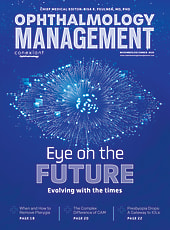Imagine a world where retinal diseases are detected before symptoms appear, where treatment plans are tailored to each patient based on precise, multimodal imaging, and where imaging systems not only capture data but guide clinicians toward better outcomes. This is no longer the distant future; it’s happening now.
Retinal imaging sits at the epicenter of ophthalmology, evolving rapidly to meet the growing demands of both clinical care and research. From cutting-edge optical coherence tomography (OCT) advancements to the seamless integration of artificial intelligence (AI), today’s imaging modalities are not just tools—they are decision-making partners. This article explores the technologies that are transforming how we see and understand the retina, focusing on innovations that are practical, impactful, and ready to make a difference in your practice.
Home OCT
In a groundbreaking shift for patient care, the US Food and Drug Administration (FDA) recently authorized marketing of the Notal Vision Home OCT system through the De Novo classification pathway, the first home-use OCT device cleared for monitoring chronic retinal conditions like neovascular age-related macular degeneration (nAMD). This approval sets a regulatory precedent, paving the way for future home OCT technologies, which are expected to become more widely available in 2025 and beyond. The De Novo classification by the FDA grants not only approval for marketing, but also creates a new classification category for future devices to have faster FDA clearance via the 510(k) process.
Home OCT enables patients to monitor disease progression in real time, reducing the need for frequent in-office visits while allowing clinicians to assess changes remotely. Scans are uploaded and sent to the patient's physician for further evaluation and monitoring, allowing early detection of retinal changes and a decrease in diagnosis to treatment times. Equipped with AI-based image analysis, these devices alert clinicians to any concerning changes, enabling timely interventions. For imaging experts, this technology offers new opportunities for analyzing longitudinal data and improving disease management outside traditional clinical settings.
OCT remains the cornerstone of retinal imaging, with continuous advancements pushing its capabilities. Recent innovations focus on speed, resolution, and adaptability to meet diverse clinical and research needs.
Why High-Speed OCT Matters
Scan speeds exceeding 150 kHz are not just a technical upgrade—they redefine workflow efficiency. Faster scans minimize motion artifacts and increase patient comfort, especially for those who struggle to maintain fixation. These systems are invaluable for high-volume practices, ensuring clear, actionable imaging without delays.
Swept-Source OCT
Swept-Source OCT (SS-OCT) is leading the charge in deeper, more comprehensive imaging. Its longer wavelength allows visualization of the choroid and vitreoretinal interface with unprecedented clarity, providing crucial insights into conditions like pachychoroid disorders and advanced glaucoma. For clinics managing complex cases, SS-OCT is becoming indispensable.
OCT-Angiography
OCT-Angiography (OCT-A) continues to solidify its role in routine clinical imaging. By offering a non-invasive alternative to dye-based angiography, OCT-A enables detailed visualization of microvascular networks in diseases such as diabetic retinopathy and AMD. Recent advancements in motion correction and segmentation algorithms enhance its reliability, making it a must-have for tracking vascular changes over time.
Fundus Autofluorescence
Fundus Autofluorescence (FAF) imaging has carved out its niche by offering insights into the metabolic health of the retina. It excels at identifying early damage to the retinal pigment epithelium (RPE), making it particularly valuable in managing conditions like macular degeneration and inherited retinal diseases.
Short-Wavelength vs Near-Infrared FAF
While short-wavelength FAF dominates clinical use, near-infrared FAF is emerging as a complementary tool. It visualizes deeper structures with less interference from media opacities, giving clinicians a broader perspective on retinal health.
Fluorescein and Indocyanine Green Angiography
Despite the rise of OCT-A, fluorescein angiography (FA) and indocyanine green (ICG) remain essential in diagnosing and managing retinal diseases requiring precise vascular imaging, such as vasculitis and polypoidal choroidal vasculopathy. These modalities continue to evolve with modern systems focused on reducing patient discomfort.
Laser-Based Angiography
The shift to laser-based angiography systems has made these procedures faster, more precise, and safer. Modern systems optimize light exposure, ensuring the clearest possible images while maintaining patient safety.
Wide-Field Imaging
The ability to visualize the peripheral retina has become critical in managing diseases like diabetic retinopathy and retinal detachments. Wide-field imaging systems now offer higher resolution and reduced distortion, capturing more of the retina with greater clarity.
Hybrid Modalities
Today’s wide-field systems integrate seamlessly with OCT and angiography, offering a complete view of retinal health. These hybrid platforms reduce the need for multiple devices, making them a practical solution for busy clinics and research centers.
Adaptive Optics
Adaptive optics (AO) is bringing cellular-level imaging into the clinical realm. While still primarily used in research, AO’s ability to visualize photoreceptors and capillaries in unparalleled detail holds immense potential for early disease detection and monitoring. Imagine Eyes’ RTX1 platform has begun to pave the way for future research capabilities. While still considered an investigational device in the United States, the device has been approved for use in South Korea, China, and Japan.
Efforts to simplify AO technology and reduce costs are making it more feasible for clinical use. Its role in tracking subtle retinal changes could revolutionize how we approach early intervention and disease management.
Artificial Intelligence: Augmenting Expertise
AI has moved from theoretical to practical in retinal imaging, offering tools that enhance, rather than replace, clinical expertise. These systems analyze images for patterns and changes, assisting in early detection and monitoring of diseases like diabetic retinopathy and AMD.
Streamlining Workflows
AI-powered software reduces the time spent analyzing imaging data, offering automated segmentation and quantification of features like fluid volumes or drusen. By automating repetitive tasks, these tools allow clinicians and imaging experts to focus on critical decision-making.
Overcoming Limitations
While AI systems are incredibly powerful, they require robust, diverse training datasets to perform effectively. Advances in real-world validation and continuous updates are addressing these challenges, ensuring AI delivers consistent and unbiased support.
What’s Next for Retinal Imaging?
The future of retinal imaging lies in integration, accessibility, and precision. Emerging trends include:
- Multi-modal platforms: Combining OCT, wide-field imaging, and angiography into single systems is becoming the new standard, simplifying workflows and providing comprehensive diagnostics.
- Customizable protocols: Imaging systems are increasingly adaptable, allowing users to tailor protocols for clinical trials, disease-specific assessments, or routine care.
- Minimally invasive techniques: Advances in light exposure reduction and safer dyes are making imaging safer for patients without compromising diagnostic quality.
Examples of Available Devices
Optos Silverstone
Integrating ultra-wide field scanning laser ophthalmoscope (UWF-SLO) with swept-source OCT enables both structural and vascular imaging across the retina. It combines 200° ultra-widefield imaging with integrated swept-source OCT, it enables capture of both peripheral and central retinal pathologies, in a single session. Its ability to image the far periphery makes it especially useful in detecting retinal tears, neovascularization, or detachments. The addition of autofluorescence, FA and ICG angiography expands its versatility. For practices managing complex retinal diseases, the Silverstone offers a streamlined approach to multi-modal imaging.
Nidek Mirante
A versatile, high performance imaging platform that combines swept-source OCT, wide field color, auto fluorescent imaging, and both FA and ICG angiography. It boasts a 163° field of view, (montaged) and allows visualization beyond the posterior pole. The system offers multimodal overlays by aligning OCT data with fundus and angiographic images for enhanced interpretation and disease localization. The device also allows practices to configure their device from basic diagnostic needs to high-end research applications.
Heidelberg Spectralis
Long regarded as the gold standard in multimodal retinal imaging, the Spectralis is a powerhouse of precision, flexibility, reliability, and offers reproducible images tailored to individual patients. Its modular architecture allows seamless integration of Spectral-domain OCT, fluorescein and ICG angiography, BluePeak autofluorescence, multicolor imaging, and OCT-A with a scan rate of 125 kHz with their SHIFT technology are all incorporated into a single, unified system.
The devices dual beam eye tracking and Automatic Real-Time (ART) averaging sets the bar high for imaging consistency, delivering exceptional clarity even with complex cases. With multiple lenses available, spanning from anterior focus all the way to the 105° wide field lens and customizable scan protocols, this device is a push beyond routine diagnostics. This device delivers, whether it be in a research setting, or in high volume clinics.
Why It Matters
Every advancement in retinal imaging, whether it is a faster OCT, a smarter AI, or a clearer wide-field image, has a direct impact on patient care. For physicians, these technologies enhance diagnostic confidence and precision. For imaging experts, they streamline workflows and reduce the time spent on technical challenges. Together, they represent the dual pillars of progress: better outcomes and greater efficiency.
Conclusion
Retinal imaging is not just about capturing better images; it’s about translating those images into actionable insights that improve lives. By focusing on innovations that enhance real-world utility, the field continues to push boundaries, ensuring that both physicians and imaging experts can provide the best possible care. As we look ahead, the challenge is not simply to adopt new technologies but to integrate them thoughtfully into practice, aligning innovation with impact. OP









